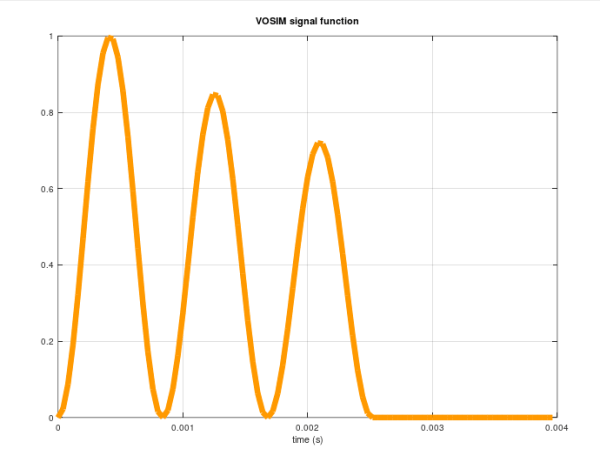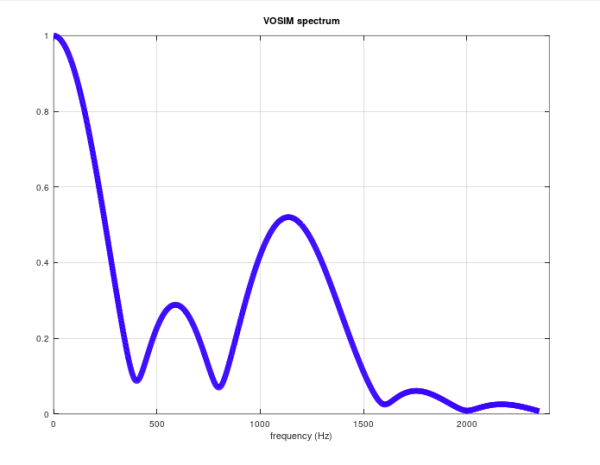
VOSIM signal with 3 pulses followed by the decay

The Vosim signal in short can be described as one or many identical sine pulses, followed by silence. Together they form "a period" in time (indicated by T'). The period is this part of the signal which is repeated to create the "fundamental frequency f0" (the main tone you hear, also called the pitch) and it's "harmonics" (f1-fn, which produce the sound quality).
Let's watch such a period in the figure below. You can see the three sines pulses which form one pulse train of length N times T, followed by the delay M. (Yellow graph) Even when this signal resembles a sine wave (in this case a sine square), it's spectral characteristics are much richer and more complicated, because of the delay after the pulse train. (Purple graph) While a sine wave only has one frequency, we find in the Vosim signal many harmonics. A second very important feature is the maximum in the spectrum. We call it the "Formant frequency". This frequency is determined by the width of the puls T.


By clicking on the links below you can download the available articles, or you will be forwarded to the site where it can be found.
In 1973 Kaegi published some of the results of his early research in Interface. In this article you can clearly see the data reduction of recorded signals, which has no major influence on the recognizability of the sound, in this case a spoken vowel /a/.
KAEGI, W. (1973) A minimum Description of the Linguistic Sign Repertoire (First Part), Interface, Vol. 2 pp.141-156
In 1974 in the second part of the article Kaegi explores also fricatives and plosives, describing his early duplications in detail.
KAEGI, W. (1974) Minimum Description of the Linguistic Sign Repertoire (Second Part), Interface, Vol. 3 pp.137-158
Stan Tempelaars, who was physicist and close collaborator of Werner Kaegi at Sonology had developed an impressive sound processing package (at that time not commercially available), which was used to make detailed FFT spectra of the sounds Kaegi analyzed and duplicated. Tempelaars published in 1977 an article in Interface about the theoretical VOSIM spectrum.
TEMPELAARS, S. (1977) The VOSIM Signal Spectrum, Interface, Vol. 6, pp.81-96
In 1986 Kaegi published a series of articles together with members of the MIDIM-group. This booklet was later jokingly called "The MIDIM-bible":
KAEGI, W. e.a.(1986) MIDIM/VOSIM-reports, Interface, Vol.15, nr. 1-5 ISSN 0303-3902
The VOSIM generators as we mentioned were developed by Jos Scherpenisse, chief technicien of the Institute of Sonology. In the next internal document you can find all the details of the microprocessor controlled design and the used software:
SCHERPENISSE, J. (1982), Internal document about the construction and design of the hardware VOSIM generators
In the late seventies and eighties some Institutes worked also with VOSIM en and published about their research, like Giovanni De Poli form the University of Padua in Italy:
DE POLI,G. e.a. (1976) Identificazione dei parametri di un oscillatore VOSIM a partire da una
descrizione spettrale, III Colloquio di Informatica Musicale,At: pages 161–177, Padova, Italy, 1976.
DE POLI,G. e.a. (1989) Generalizza dell'Oscillatore Vosim per la Sintesi del Suono, VIII Colloquio di Informatica Musicale, Caligari 26
DE POLI,G. e.a. (1979) Determinazione dei parametri VOSIM di un suono quasi periodico, Convegno Associazione Italiana di Acusticaa 79 (AIA 79)At: volume II, pages 41–43, Roma, 1979. Esa - Edizioni Scientifiche Assoc